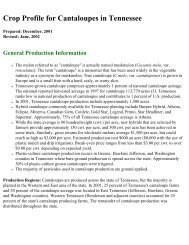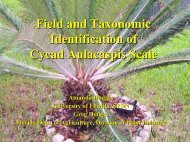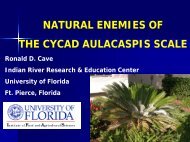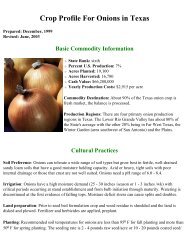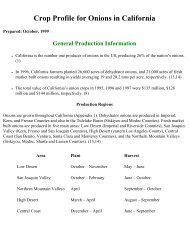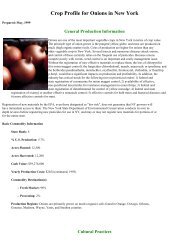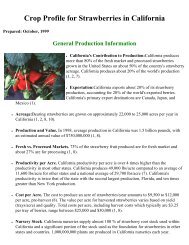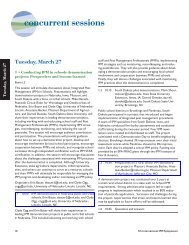Crop Profile for Cherries (Sweet) - Regional IPM Centers
Crop Profile for Cherries (Sweet) - Regional IPM Centers
Crop Profile for Cherries (Sweet) - Regional IPM Centers
Create successful ePaper yourself
Turn your PDF publications into a flip-book with our unique Google optimized e-Paper software.
attractive to the population than the ripening apples, then killed by relatively inexpensive insecticides<br />
outside of the orchard. This process is being researched and has not yet been demonstrated to be<br />
effective.<br />
Most control requires repeated applications of insecticide, especially along the borders of orchards,<br />
during the period of adult in-flight.<br />
Chemical Control<br />
Endosulfan (Thiodan 50WP) - Endosulfan is the only registered product that provides adequate control<br />
of true bugs. This product is used only rarely. Most growers do not spray to control this pest, as<br />
populations are low in the earlier part of the growing season when fruit is ripening. When it is used it is<br />
applied at 2.0 lbs. a.i./acre, usually only once a season. Application is made in early May, as the preharvest<br />
interval is 21 days.<br />
Alternatives<br />
None have been shown effective, though research continues.<br />
Cultural Control Practices<br />
Some growers have attempted to remove host plants from the brush lands bordering the orchard in an<br />
ef<strong>for</strong>t to reduce the build-up of the bug population during the spring and summer. This approach has had<br />
some very limited effect but does not provide adequate control.<br />
Biological Controls<br />
Bugs have many predators, parasites, and parasitiods, but seem to withstand them well. There are<br />
variations in the numbers of bugs moving into orchards from one season to another; it is possible that<br />
weather and biological factors influence these differences.<br />
TETRANYCHID MITES<br />
European Red Mite, Panonychus ulmi(Koch)<br />
Two-Spotted Spider Mite, Tetranychus urticae (Koch)<br />
McDaniel Mite, Tetranychus mcdanieli (McGregor)<br />
The European red mite is the most common and potentially serious mite that attacks tree fruits in<br />
Washington. It was introduced into the state in the early 1900s and caused significant damage until the



